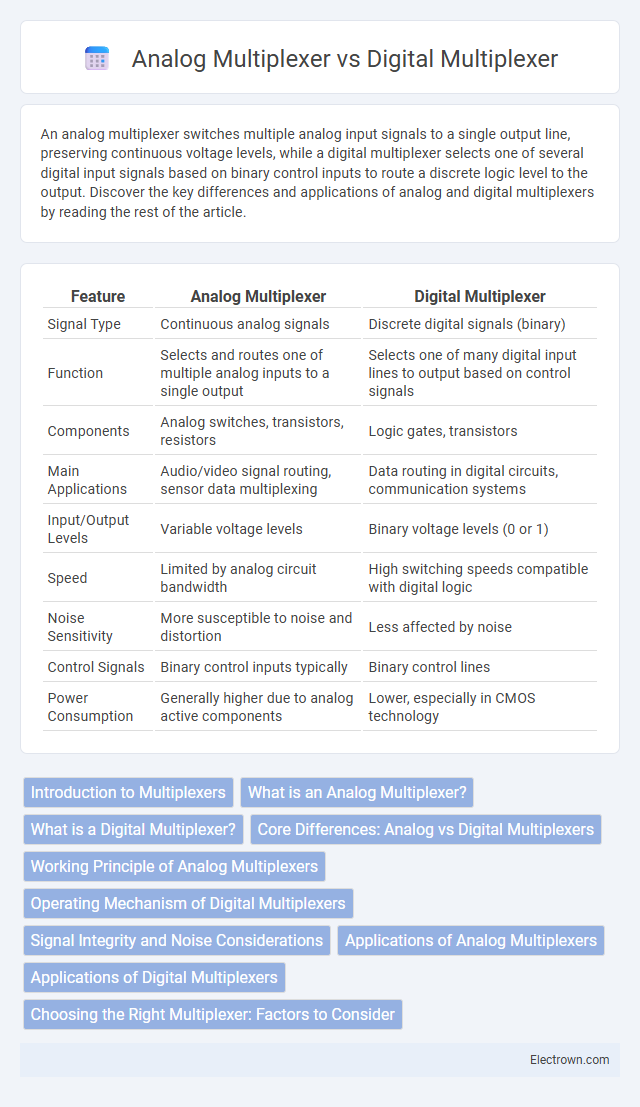An analog multiplexer switches multiple analog input signals to a single output line, preserving continuous voltage levels, while a digital multiplexer selects one of several digital input signals based on binary control inputs to route a discrete logic level to the output. Discover the key differences and applications of analog and digital multiplexers by reading the rest of the article.
Table of Comparison
| Feature | Analog Multiplexer | Digital Multiplexer |
|---|---|---|
| Signal Type | Continuous analog signals | Discrete digital signals (binary) |
| Function | Selects and routes one of multiple analog inputs to a single output | Selects one of many digital input lines to output based on control signals |
| Components | Analog switches, transistors, resistors | Logic gates, transistors |
| Main Applications | Audio/video signal routing, sensor data multiplexing | Data routing in digital circuits, communication systems |
| Input/Output Levels | Variable voltage levels | Binary voltage levels (0 or 1) |
| Speed | Limited by analog circuit bandwidth | High switching speeds compatible with digital logic |
| Noise Sensitivity | More susceptible to noise and distortion | Less affected by noise |
| Control Signals | Binary control inputs typically | Binary control lines |
| Power Consumption | Generally higher due to analog active components | Lower, especially in CMOS technology |
Introduction to Multiplexers
Multiplexers are essential devices used to select one input signal from multiple inputs and forward it to a single output line, streamlining data transmission and processing. Analog multiplexers handle continuous signals, making them ideal for audio or sensor data, while digital multiplexers manage discrete binary signals used in computer and communication systems. Understanding the difference between analog and digital multiplexers helps you optimize signal routing and resource utilization in your electronic designs.
What is an Analog Multiplexer?
An analog multiplexer is a device that selects one of several analog input signals and forwards the chosen signal to a single output line, enabling efficient signal routing in electronic systems. It operates on continuous voltage signals, preserving the original waveform without converting it to digital form, making it ideal for audio, sensor, and communication applications. Your choice of an analog multiplexer depends on factors like channel count, signal bandwidth, and on-resistance to ensure minimal signal distortion.
What is a Digital Multiplexer?
A digital multiplexer is an electronic device that selects one of several digital input signals and forwards the chosen input into a single output line based on control signals. Unlike an analog multiplexer, which handles continuous analog signals, a digital multiplexer processes discrete binary data, ensuring precise signal routing in digital circuits. Understanding the role of a digital multiplexer helps you optimize data flow in complex digital systems and improve overall performance.
Core Differences: Analog vs Digital Multiplexers
Analog multiplexers transmit continuous voltage signals, preserving the original signal's analog waveform across multiple inputs, making them ideal for sensor data or audio signals. Digital multiplexers handle discrete binary signals, routing one of several digital input lines to a single output based on control logic, widely used in digital circuits and communication systems. Understanding these core differences helps you select the appropriate multiplexer type for signal integrity and system design requirements.
Working Principle of Analog Multiplexers
Analog multiplexers operate by channeling multiple analog input signals through a single output line based on control signals that select one input at a time. Their working principle relies on electronic switches, such as MOSFETs, to pass analog voltages or currents without converting them to digital form. Understanding this helps you choose the right multiplexer type for handling continuous signals where preserving signal integrity is essential.
Operating Mechanism of Digital Multiplexers
Digital multiplexers operate by selecting one of many binary input signals based on control signals, routing the chosen input to a single output line. They use logic gates to decode control inputs that determine which data input passes through, enabling efficient signal management in digital circuits. Your digital systems benefit from precise, fast data selection and minimal signal degradation due to the binary switching nature of these multiplexers.
Signal Integrity and Noise Considerations
Analog multiplexers maintain signal integrity by preserving continuous voltage levels but are more susceptible to noise and crosstalk due to analog signal variations. Digital multiplexers offer better noise immunity and signal integrity by handling discrete digital signals, minimizing distortion and interference in data transmission. Your choice depends on whether preserving analog signal fidelity or ensuring robust digital communication is more critical for your application.
Applications of Analog Multiplexers
Analog multiplexers efficiently route multiple analog signals into a single output line for instrumentation systems, audio and video signal processing, and sensor data acquisition. They enable streamlined data collection in medical devices by selecting between various sensor inputs without signal degradation. Industrial automation benefits from analog multiplexers by facilitating real-time monitoring of analog inputs across complex control systems.
Applications of Digital Multiplexers
Digital multiplexers are essential components in communication systems, enabling the selection and routing of multiple digital signals into a single data line, which optimizes bandwidth usage in networking devices such as routers and switches. They are widely used in microprocessor systems for data selection and bus management, facilitating efficient data transfer and processing. Digital multiplexers also play a critical role in digital signal processing applications, including data acquisition systems and digital communication protocols, where precise timing and signal integrity are crucial.
Choosing the Right Multiplexer: Factors to Consider
Choosing the right multiplexer involves assessing signal type compatibility, with analog multiplexers suited for continuous voltage signals and digital multiplexers designed for discrete binary data. Key factors include signal integrity requirements, bandwidth, switching speed, and noise tolerance, where analog types require low distortion and digital types demand fast, accurate state transitions. Power consumption and integration complexity also influence selection, as analog multiplexers often handle varied voltage ranges while digital multiplexers excel in microprocessor-based systems.
analog multiplexer vs digital multiplexer Infographic

 electrown.com
electrown.com